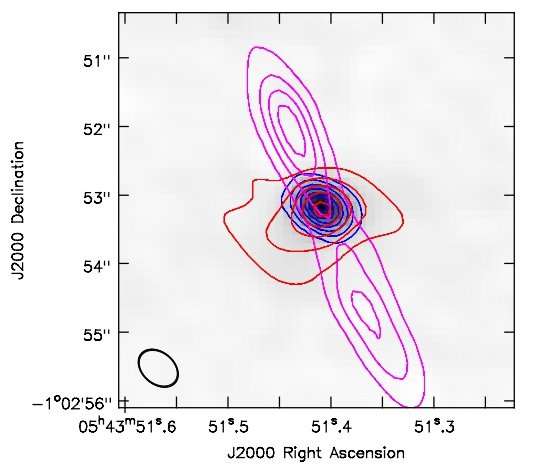January 30, 2018 report
Deuterated formaldehyde detected in protostar HH 212

Using the Atacama Large Millimeter Array (ALMA) in Chile, a team of researchers has detected the emission of deuterated formaldehyde (HDCO) from the hot inner region of the protostar HH 212. The finding, reported January 20 in a paper published on the arXiv.org pre-print repository, could be helpful in our understanding of chemical processes in this protostar and in similar objects.
HH 212 is a low-mass protostellar system located some 1,300 light years away in the Orion constellation. Previous studies of this protostar, conducted in 2016 and 2017, found that its "hot corino" (the warm inner region of the envelope surrounding the low-mass protostars) contains deuterated water (D2O) and singly deuterated methanol (CH2DOH).
Recently, a team of scientists led by Dipen Sahu of the Physical Research Laboratory (PRL) in Ahmedabad, India, has analyzed archival data obtained by ALMA, which observed HH 212 in December 2012. The analysis allowed the researchers to identify an emission of another molecule from the protostar's hot corino – deuterated formaldehyde.
"In this paper, we use ALMA archival dataset 2011.0.00647.S and report emission of deuterated formaldehyde line from central hot-corino region," the authors wrote in the paper. The study reveals that the emission of HDCO is assumed to be optically thin and is limited mainly to the inner 200 AU from the center of HH 212. The emission is concentrated in a circular region around the central protostar position and is elongated along the jet direction. However, Sahu's team was not able to infer conclusively whether the elongation is real or due to the effect of the synthesized beam size.
The researchers assume that the HDCO emission originates near the central hot region, given that the emission is almost symmetric around the systematic velocity between 1.6 and 2.0 km/s. The column density of HDCO was calculated to be 100 trillion cm−2. Furthermore, the scientists revealed that HDCO emission experiences a rotation, most likely associated with the disk wind or rotating environment. However, due to limited resolution of the observational data provided by ALMA, the authors of the paper cannot select the most plausible scenario at the moment.
In order to determine the origin of HDCO emission, the researchers compared it with methanol (CH3OH) and C17O emission. For instance, they found that HDCO emission is more extended than methanol, and HDCO has a red-shifted peak which is absent in methanol emission.
"We compare HDCO line with other molecular lines to understand the possible chemistry and physics of the source," the paper reads.
The authors concluded that the deuterium fractionation of formaldehyde is relatively higher than methanol in the central region of HH 212. They assume that the gas phase formation of deuterated formaldehyde is active in the central hot region of the protostar.
"From the possible deuterium fractionation, we speculate that the gas phase formation of deuterated formaldehyde is active in the central hot region of the low-mass protostar system, HH 212," the researchers wrote in concluding remarks.
More information: Deuterated Formaldehyde in the low mass protostar HH212, arXiv:1801.06699 [astro-ph.GA] arxiv.org/abs/1801.06699
Abstract
HH212, a nearby (400 pc) object in Orion, is a Class 0 protostellar system with a Keplerian disk and collimated bipolar SiO jets. Deuterated water, HDO and a deuterated complex molecule, methanol (CH2DOH) have been reported in the source. Here, we report the HDCO (deuterated formaldehyde) line observation from ALMA data to probe the inner region of HH212. We compare HDCO line with other molecular lines to understand the possible chemistry and physics of the source. The distribution of HDCO emission suggests it may be associated with the base of the outflow. The emission also shows a rotation but it is not associated with the Keplerian rotation of disk or the rotating infalling envelope, rather it is associated with the outflow as previously seen in C 34 S. From the possible deuterium fractionation, we speculate that the gas phase formation of deuterated formaldehyde is active in the central hot region of the low-mass protostar system, HH212.
© 2018 Phys.org





















